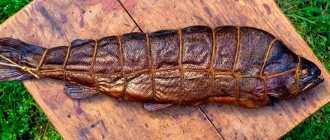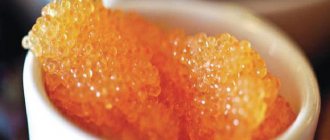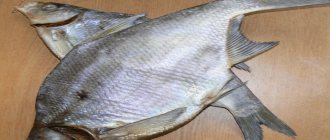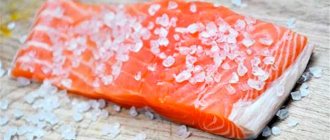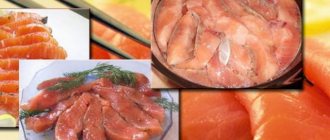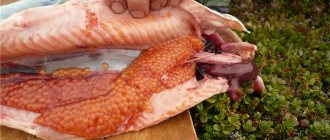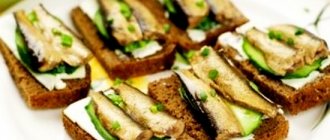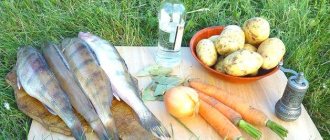If the fish is freshly caught, then its body is covered with mucus. The carcass must be rubbed with salt so that it does not slip out of your hands, and rinsed thoroughly with running water. After cleaning the mucus, the carcass must be dried (you can blot it with paper towels).
After this, prepare for cleaning sharp knives, cutting scissors and a board, containers for caviar (it is salted), milk (they can be fried) and waste.
Knife with a short handle
To prevent the scales from scattering in all directions when cleaning with a kitchen knife with a short handle, the fish can be kept in water by placing it in a sink or basin. The carcass should be held by the tail while cleaning. The process should be carried out without haste, making small movements in the direction from the tail to the head. The scales of a trout are easily separated from the skin, but they “sit” more firmly on the belly. You can wash off the peeled scales from time to time to see the places where they still remain (identify by their shine). You may need another tool to continue the process.
Precautionary measures
Before removing the gills from a fish, pay attention to the following.
Some species have acquired an abundance of protective devices. For example, pike perch, in the process of evolution, grew sharp spines on their fins. The gills may also have prickly edges.
If you try to pull out the gills by hand, especially when cleaning large fish, you risk injuring yourself. To prevent this from happening, inspect the surface and do not make jerks. You can even use ordinary pliers to remove the gills, but you need to pull not from the middle of the arc, but from the very edge.
Otherwise, the gills will tear, and you will have more work: getting rid of torn flaps is more difficult than getting rid of a whole organ.
How to fillet
The fish, cleaned and washed again, must be prepared for further culinary processing. If you are going to bake the whole fish, then you don’t have to gut it or cut off the fins, but the gills must be removed, because. they will ruin the dish.
For all other culinary delights, trout should be gutted and cut. On a fish cutting board, you need to place the carcass so that it is convenient to cut off all the fins and open the belly with scissors or a sharp knife from the anal fin to the gill wings. Take out all the insides.
To fillet the head, you do not need to cut it off; an incision is made around it and along the entire back to the vertebral bone. Then, prying the meat at the head with a knife, you need to smoothly move the sharp blade of the knife along the ridge to the tail. Rib bones that may separate along with the meat are carefully cut off with a knife or removed using tweezers.
Further processing of the fillet depends on the recipe according to which the trout will be prepared.
An important condition is that the knife must be sharp, and it must be moved only forward, pressing the blade against the skin when cutting, without sawing movements, so as not to turn the tender fillet into a loose porridge.
Gill removal process
Our step-by-step instructions will help you overcome any gills. The process should begin after cleaning the fish from scales. Let's look at how to remove gills from fish:
- Turn the carcass belly towards you. Bend the operculum on one side and make an incision near the frontal attachment of the gill arch. To do this, you can use either a sharp knife or culinary scissors.
- Do the same with the 2nd gill arch.
- Bend back the frenulum that connects the gill arches under the fish's mouth.
Insert a sharp knife through and cut off both gill arches from the frenulum. - Carefully remove the gills.
- Rinse the carcass under running water, exposing the place where the gill arches were attached to the stream.
That's all the wisdom. If this is the first time you have thought about how to remove gills from a fish, then most likely you have imagined a difficult and labor-intensive process. Maybe on the first try he will turn out to be one. But with a little practice, you can easily handle the task.
Cutting whole fish for fish soup and steaks
Salmon species are tasty in any form. For fish soup, you can use only the heads and tails, separating them from the whole carcass after cleaning them from scales. The gills should be cut out from the head, because... Dirt accumulates in them, and the taste and smell of the organs can spoil the dish. All other parts of the head are edible and easy to chew once cooked.
Strips of peritoneum for fish soup can also be cut off from the main carcass, but more often they are left. Classic steaks are made from the gutted carcass (with or without bellies). To do this, a trout carcass with skin and without a head is cut crosswise with a long sharp knife.
The pieces should not be too thin. To make the steaks crispy and juicy, the thickness of the piece should be about 3 cm.
Steaks can also be cut crosswise from whole fillets into wide strips. This way the pieces of meat will be boneless. If there are rib bones left on the fillet, they can be easily removed by prying them together with the film that is in the abdominal part with a thin flexible knife. Then, if desired, you can separate a piece of meat from the skin.
Some cleaning tips
- If you follow some rules, the process will not be burdensome. For example:
- It is better to clean fish in a sink. This will protect the kitchen from unnecessary dirt and save time on cleaning and cleaning.
- For cleaning fish, a knife with a short handle, but rather sharp, is more suitable.
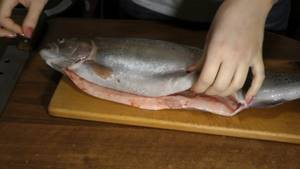
- If there is no option with a sink, then it is better to cut the fish on a cutting board. At the same time, it is very important that the fish cutting board is not used for preparing other food products, except for cooking meat. This is especially true when bread, cheese, sausages, etc. are cut on a cutting board.
- If you need to put fish in the freezer, you should make sure that there is as little moisture on it as possible.
- It is advisable to clean and cut the fish immediately after purchase.
- When it is completely defrosted, this technological process will take much longer.
Not much advice
To remove the backbone and bones, it is necessary to make a deep cut to divide the fish carcass into two parts. This is the only way to get rid of bones without any problems.
The knife should pass in close proximity to the vertebrae of the fish and follow a sliding path. In this case, you need to control the position of the knife. The knife should go at an angle, towards the abdomen. This process requires holding the fish carcass motionless.
After this, the remaining bones are removed. They are easy to spot if you run your finger across the meat. They are removed using tweezers or nail scissors. To remove the skin from the meat, first make an incision, after which, holding the fish, the meat is cut off from the skin. At the same time, you should also control the position of the knife. It should be at an angle to the table, or rather, at an angle to the skin.
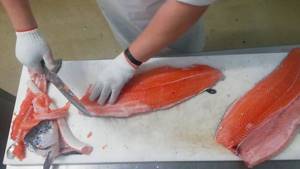
This is the only way to properly separate the meat from the skin. Similar actions are needed when you need to prepare salad and rolls, as well as those dishes that require small pieces of meat. When cutting trout, you should remember that from such parts of the fish as the ridge, head, tail and fins you can actually cook the most delicious and healthy fish soup.
Useful properties of trout

Vitamins and microelements
A whole bunch of vitamins and minerals, as well as other useful substances, were found in trout meat.
- Meat contains B vitamins.
- And also vitamins A and D.
- Its meat contains microelements such as phosphorus, magnesium, potassium, etc.
- With regular consumption, due to the presence of Omega 3 fatty acids, there is a decrease in bad cholesterol in the human body. In addition, useful components do not allow plaques to form on the walls of blood vessels.
- The presence of choline in trout meat promotes the generation of nerve cells in the human body. In addition, the skin is healed and restored, as well as the body is cleansed of toxins and toxic substances.
Energy value
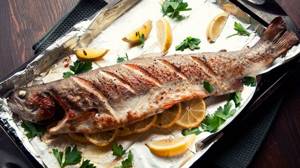
100 grams of pure trout meat contains:
- Proteins – 21 grams.
- Fats – 7 grams.
- Water – 72 grams.
- Fatty acids – 1.15 grams.
- Good cholesterol – 58 mg.
- Ash – 1.8 grams.
100 grams of trout contain 190 calories.
Contraindications

Experts do not recommend consuming trout meat for pregnant women and young mothers who are breastfeeding. Fish meat is quite fatty, so it is not recommended for people suffering from problems with the gastrointestinal tract. The meat of this fish will not benefit hypertensive patients and patients with cardiovascular diseases.
Before eating the head, pay special attention to the gills. It is better to remove them, since a lot of harmful substances accumulate in the gills. If this is not done, the taste of the dish will be irrevocably spoiled.
The process of cleaning trout is practically no different from cleaning other fish. The main thing here is to approach each stage carefully and with full responsibility. This is the only way to obtain a high-quality final product. It should also be remembered that the quality of the final product largely depends on the quality of the original product.
Igor 01/05/2018
Fillet cutting for salting and frying
To cut trout for salting or frying, you need to fillet the carcass. To do this, you need to know how to separate the ridge and all other bones, and also take into account important nuances of the process. It’s not so easy to do all this, so it’s better to practice on cheaper fish.
The work is carried out as follows:
- The first step is to gut the trout. To do this, make a longitudinal incision in the abdomen and carefully remove all the insides.
- The carcass is placed on a cutting board with its back facing up.
- Using a special knife, a cut is made from the base of the head to the tail.
- Then a transverse cut is made, trying to get as close to the ridge of the fish as possible.
- After this, turn the carcass over and perform similar actions.
- Rib bones are cut from 2 large fillet pieces.
- At the next stage of work, the dorsal and ventral fins are removed.
- Using tweezers, remove all small bones.
- At the very end, the fish is placed on a cutting board and the skin is separated. This is done with a thin and sharpest knife.
Skin the fish and remove the bones
If the fish is small in size, then you can remove the skin from it using the stocking principle. Grab the fish by the carcass with one hand, the head with the other and pull the head back to break the backbone. Then remove the skin with a stocking. Wash the fish in cool running water and remove any remaining skin.
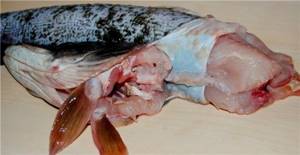
If the fish is large (more than 200 grams), then first separate the head and tail. Then we cut the fish lengthwise along the ridge to the tail. Thus, we got two halves of fish, each of which must be placed skin-on on a cutting board and, slightly lifting, cut off the skin. Then cut off the spine and remove all the bones with your hands or tweezers.

That's all! We received a completely clean trout fillet without bones or skin.
If you are freezing fish, you need to wipe the fish dry before putting it in the freezer.
Removing scales
The first step is to remove the scales from the trout. The body of the fish is slimy, so before you start cleaning, you need to wash the carcass under running water. If this does not help get rid of the mucus, you can rub the fish with a lot of salt, this will add additional friction and prevent the carcass from slipping out of your hands.
Trout scales are small and easily separated from the skin. Therefore, it’s easy to clean trout from scales; a small knife with serrated edges is suitable for this, but if you don’t have one on the farm, you can use an ordinary one.
The scales must be carefully scraped from the surface of the skin, being careful not to destroy it. Almost everyone complains that the scales fly apart a lot, but in fact, if you act carefully everything will be fine.
Advice! If you can’t carefully remove the scales, you can clean the fish by immersing it in water. Or by putting it in a bag and placing your hands in it.
The scales on the side surface of the carcass are simply removed, but you will have to tinker with the abdomen. The skin on it is more tender, and the scales sit tighter. Another distinctive feature is that on the belly the skin is lighter and the scales are difficult to see. In order not to miss the scales and not spoil the dish, you need to inspect their presence by running your finger against the direction of the scales.
This will help you find fragments of the uncleaned abdomen. Finally, you need to wash the fish and remove any remaining plates.
